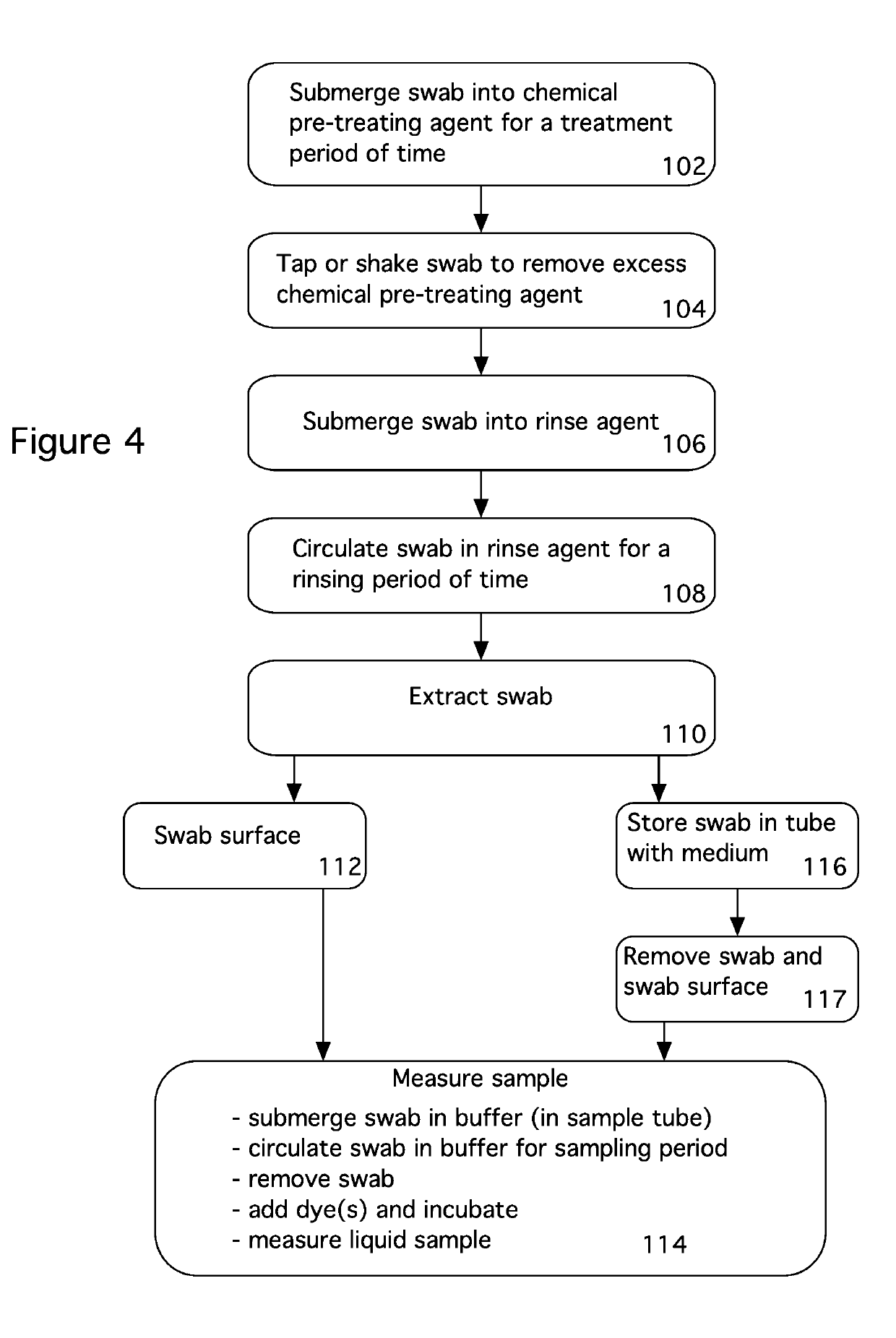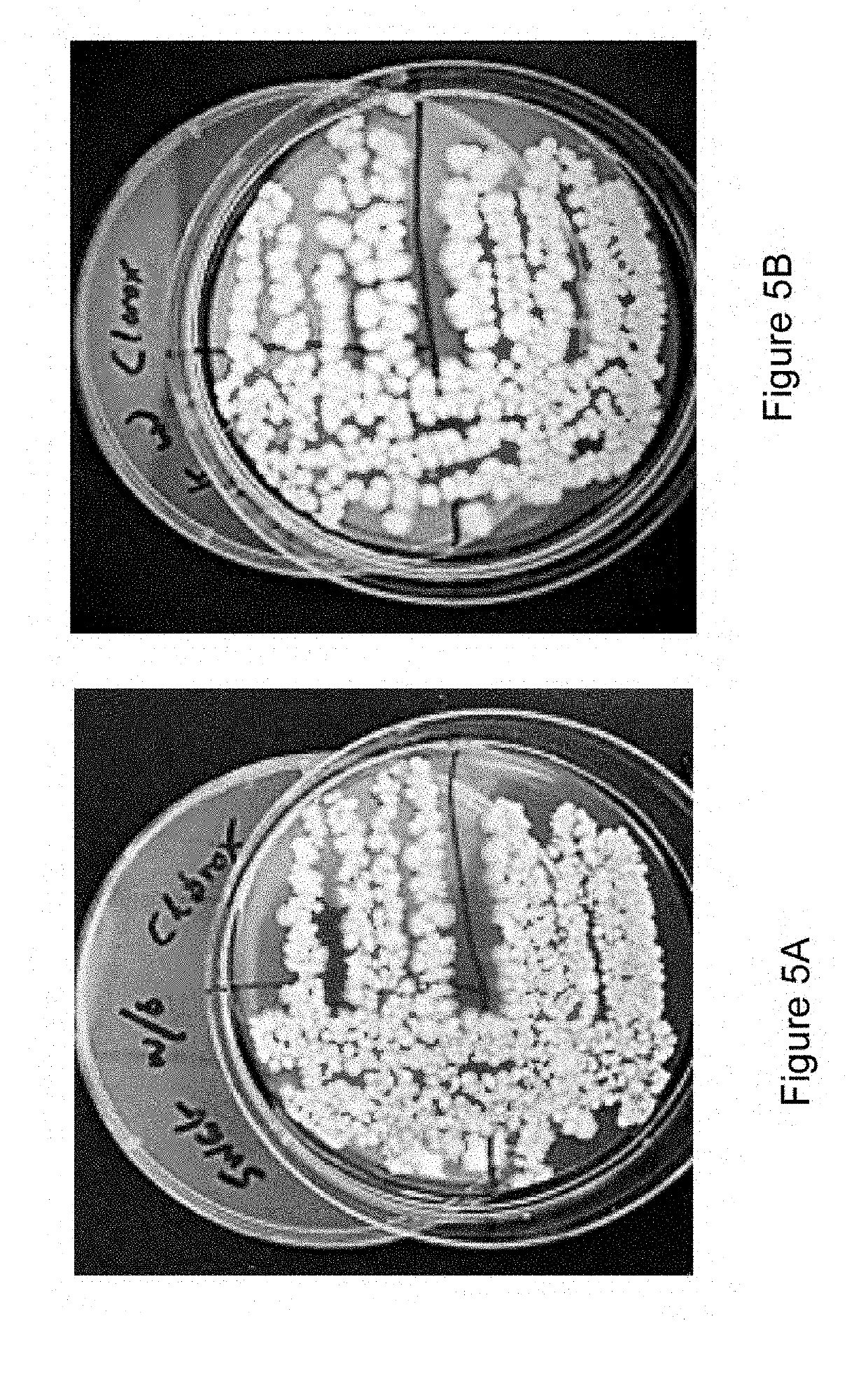Apparatus and Methods For Pre-treating Swabs Prior to Collection of Specimens to Reduce False Positive Detections
a technology of pretreatment and swab, which is applied in the field of pretreatment swabs, can solve the problems of infrared black dyes that are also viable, and achieve the effects of reducing autofluorescence, reducing false positive detections, and eliminating/reducing active bonding sites for dye nucleation or bonding
- Summary
- Abstract
- Description
- Claims
- Application Information
AI Technical Summary
Benefits of technology
Problems solved by technology
Method used
Image
Examples
example 1
[0022]A Copan swab 30 (R4160) in 10 mL of SRK buffer 11 (an isotonic salt buffer; as in the arrangement shown in FIGS. 1 and 2) is taken from its storage tube 10 and prepared by dipping the swab 20 in a plastic centrifuge tube (pre-treatment tube) of a chemical pre-treating agent (step 102). Examples include Clorox bleach, 3% hydrogen peroxide, and fluorescence suppressing dyes. The time of immersion varies from 1 to 10 minutes depending on the composition and concentration of the immersion fluid. After removal, the swab is shaken or tapped to remove excess cleaning liquid (step 104, optional). The swab is then inserted into a rinsing tube containing rinse buffer (step 106), typically sterile PBS (phosphate-buffered saline), on a rotating lab platform to keep buffer circulating around the swab, typically at 2 Hz (step 108). Using a chemical suppressant that renders the staining dye non-fluorescent (e.g. Clorox bleach) will reduce background, but also unacceptably reduces signal from...
example 2
[0028]Trypan blue and Evans blue have emission spectra that are well outside our dye fluorescence detection wavelength band (530 nm), with Evans Blue having an emission peak at 650 nm and Trypan blue at 670 nm. Proceeding as per Example 1, a Copan swab (R4160) in 10 mL of SRK buffer (an isotonic salt buffer; as in the arrangement shown in FIGS. 1 and 2) was taken from its storage tube and prepared by dipping the swab in a plastic centrifuge (pre-treatment) tube of Evans blue stain (20 ul / 10 ml of the Evans blue stock solution given above into PBS) using the protocol from FIG. 4 (step 102). The time of immersion varies from 104). The swab is either used (step 112) or placed into a storage tube (step 116; similar to what is shown in FIG. 1), prior to eventual use (step 117). The sample is measured in step 114 as above. Sampled particles are removed by shaking, vortexing, inversion, and or stimulation of sample circulation in its sampling tube. When the sample is ready for analysis, th...
example 3
[0029]Proceeding as per Example 1 shown in FIG. 4, a rod with a spatulate foam end 20B (such as Puritan 25-1805 1PF RND FDNA shown in FIG. 3) is processed using the same steps as Example 1, but with immersion and storage (step 116) in wider mouth containers to accommodate the larger breadth of the swab.
[0030]Determination of Efficacy of Pretreatment
[0031]To determine the efficacy of pretreatment protocols for swabs using an oxidizing or reducing bleaching agent, experiments were performed using Fountain Flow cytometry as an assessment tool, measuring false positive detections before and after treatment (as per the Examples above). The results are summarized in Table 1 as detections / ml of sample. The samples were analyzed on a Fountain Flow cytometer as described in Johnson, Moriwaki, and Johnson, J Clin Lab Anal 2017, 31(6).doi:10.1002 / jcla.22115. Staining of the sample was performed using SYBR Green I with a 10 m dye incubation period followed by Evans blue as described above.
TABLE...
PUM
| Property | Measurement | Unit |
|---|---|---|
| Fraction | aaaaa | aaaaa |
| Nanoscale particle size | aaaaa | aaaaa |
| Volume | aaaaa | aaaaa |
Abstract
Description
Claims
Application Information
 Login to View More
Login to View More - R&D
- Intellectual Property
- Life Sciences
- Materials
- Tech Scout
- Unparalleled Data Quality
- Higher Quality Content
- 60% Fewer Hallucinations
Browse by: Latest US Patents, China's latest patents, Technical Efficacy Thesaurus, Application Domain, Technology Topic, Popular Technical Reports.
© 2025 PatSnap. All rights reserved.Legal|Privacy policy|Modern Slavery Act Transparency Statement|Sitemap|About US| Contact US: help@patsnap.com



